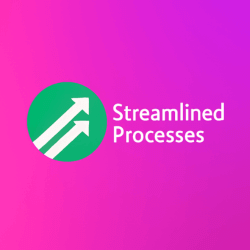For Business Process Optimization Software, see our main page here.
What Is Business Process Optimization Software?
Business Process Optimization Software helps organizations streamline operations, improve quality, and reduce waste. It’s used to analyze workflows, automate routine tasks, and enhance cross-team coordination. As a result, businesses can work more efficiently, cut costs, and make better decisions.
This type of software combines data analytics, process mapping, and automation to drive continuous improvement. For example, a logistics company might use it to reduce delivery delays by analyzing traffic patterns and fleet activity. On the other hand, a healthcare provider could use it to minimize paperwork and increase patient throughput.
Today, businesses across sectors—from retail to manufacturing to finance—are investing heavily in these tools. Why? Because continual refinement of internal processes leads to higher productivity, better customer satisfaction, and stronger profits.
Key Features to Look for in Business Process Optimization Software
- Workflow Automation: Automates repetitive tasks, reducing human error and saving time.
- Process Mapping: Visualizes workflows to identify inefficiencies and bottlenecks.
- Analytics and Reporting: Provides data to measure performance and process effectiveness.
- Integrations: Connects with CRM, ERP, and other tools to streamline operations.
- Role-based Access: Controls who can view, edit, or approve specific workflow elements.
Most importantly, your chosen solution should scale with your business. A tool that works for a startup may not suit a large enterprise, and vice versa. Therefore, flexibility and customization play a crucial role in software selection.
How Businesses Benefit from Business Process Optimization Software
Adopting Business Process Optimization Software often leads to dramatic improvements. For instance, an e-commerce company reduced customer complaints by 30% after automating its return and exchange process. Similarly, a medium-sized law firm cut client onboarding time by 50% using digital intake forms and automated document workflows.
In addition to speed and accuracy, these tools improve transparency across the organization. Real-time dashboards show who’s doing what and where delays may occur. This clarity boosts accountability and simplifies performance tracking.
Further, when processes are documented and optimized, it’s easier to train new employees. That reduces onboarding time and ensures consistent experiences for clients and team members alike.
Popular Tools: A Quick Comparison
There’s no one-size-fits-all solution. Yet, several platforms stand out in the field of Business Process Optimization Software:
- Kissflow: Great for mid-sized businesses seeking no-code automation. Offers process modeling and team collaboration tools.
- Nintex: Known for its robust process mapping and deep enterprise integrations. Often used in regulated industries like insurance and banking.
- ProcessMaker: Lightweight and open-source, ideal for companies with custom workflows and IT expertise.
- Zapr: Focuses on automation via app connections, particularly useful for marketing and communications teams.
While they all aim to optimize operations, each tool prioritizes different features. So, evaluate them based on your current pain points and future goals. Also, consider trial versions to explore usability firsthand.
Emerging Trends in Business Optimization
The landscape is shifting rapidly. One major trend is the rise of AI-driven decision-making. Modern Business Process Optimization Software increasingly uses machine learning to recommend process improvements proactively. For example, AI might detect that approvals consistently come from the same manager and suggest automation.
Another trend is real-time collaboration. Teams across time zones can now work on process designs simultaneously, improving speed and alignment. Likewise, mobile capabilities are expanding to meet remote work demands.
Cloud-based platforms are also becoming the standard due to easier updates and scalability. Above all, businesses need to remain agile, and cloud access ensures that updates and new workflows can be implemented quickly and securely.
Common Mistakes to Avoid
Despite its benefits, Business Process Optimization Software can backfire if misused. Common pitfalls include:
- Lack of Planning: Rushing to implement without a clear goal often causes confusion and resistance.
- Over-Automation: Not every task should be automated. Tasks requiring human judgment may suffer.
- Poor Integration: Software that doesn’t sync with existing systems creates silos rather than removing them.
- Not Involving Teams: Excluding end users from evaluations can result in low adoption and poor ROI.
To avoid these issues, start with a thorough needs analysis. Involve process owners and IT early. Most importantly, test solutions with a small group before scaling.
Successful Implementation: A Case Study
One regional hospital offers a great example of success. They faced long wait times and staff burnout in their outpatient department. After analyzing patient workflows and feedback, leadership adopted Business Process Optimization Software to digitize forms, add kiosks for check-in, and automate doctor scheduling.
Within six months, wait times dropped by 40%. Staff reported higher job satisfaction. As a result, the hospital saved both time and money while improving patient care. Their approach—combining detailed analysis with the right technology—made the difference.
FAQ: Business Process Optimization Software
Q: How long does it take to implement Business Process Optimization Software?
A: It depends on the software and complexity of your workflows. Simple setups may take weeks; enterprise installs could take months.
Q: Is it suitable for small businesses?
A: Absolutely. Many platforms offer tiered pricing and no-code interfaces tailored to small and midsize teams.
Q: Can I use it without coding knowledge?
A: Yes. Many tools are designed for business users with drag-and-drop builders and built-in templates.
Q: What industries benefit most?
A: Finance, healthcare, logistics, legal, and retail industries often see the biggest gains. That said, any operationally complex business can benefit.
Q: How do I measure ROI?
A: Track KPIs like time savings, error reduction, and employee satisfaction. Over time, compare these against your initial benchmarks.
Final Thoughts on Optimizing Operations
Business Process Optimization Software empowers teams to work smarter, not harder. It gives leaders the tools to boost performance, reduce waste, and unlock innovation. But, success doesn’t come from tools alone. Strategy, collaboration, and ongoing improvement matter just as much.
This article was created with the assistance of AI tools and reviewed by our team at Streamlined Processes LLC to ensure accuracy and relevance.
Follow us on Facebook here.

